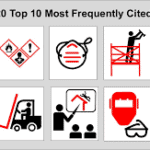This year marks the 50th year of the Occupational Safety and Health Act. Signed into law in 1970 and enacted on April 28, 1971, the OSH Act requires that employers follow all relevant OSHA safety and health standards and correct all safety and health hazards. Today, OSHA has jurisdiction over approximately 7 million worksites and has significantly reduced workplace fatalities, injuries and illnesses through their enforcement program over the past five decades. OSHA compliance officers are safety professionals or industrial hygienists who conduct inspections based on imminent danger situations, worker fatalities or hospitalizations, severe injuries or illnesses, worker complaints, referrals, targeted inspections aimed at specific high hazard industries or follow-up inspections. Each OSHA inspection can be broken down into three main parts; the opening conference, the actual inspection or “walk around” and the closing conference. Knowing what to expect during these three critical parts of an OSHA inspection can help your company be prepared and avoid the stress of an OSHA inspection. Here are some tips to help you get ready:
1. Have a safety culture in place and provide ongoing training programs
The easiest way to make a visit from OSHA stress free is to make sure your company has a robust safety and health management program in place and is offering ongoing safety training to your employees and supervisors. Since there is no way to know when OSHA will arrive, it is best to plan for an inspection before it happens. Ensure every employee has the required safety training and it is up to date. Keep in mind, if it isn’t documented, OSHA will not know whether the training happened or not.
2. Be polite and professional
When an OSHA compliance officer arrives at your facility, he or she will begin by showing his or her credentials. If this information is not volunteered, you should ask to see this information. If you are unsure, call the local OSHA office or the Department of Labor office to confirm. The compliance officer will explain why OSHA is inspecting the workplace and describe the scope of the inspection. Remember to be polite, courteous and professional, but don’t be afraid to ask questions.
3. Designate a company representative and back up representative
Advance preparation is important and designating a company representative is key to making the process go smoothly. This person can be a safety director, safety manager, someone in upper management or even the company owner. An ideal candidate for this role is someone who is familiar with OSHA standards, your company’s health and safety program and the location of the required OSHA records and logs. If your representative is not available on the day OSHA arrives, you may ask the compliance officer to wait for your representative to arrive. If that is not possible, it may be beneficial to have a back up representative prepared to take on this important role.
4. Require PPE and follow all safety rules
Before beginning the “walk around”, be prepared to provide the required PPE to the compliance officer should they not have the required safety gear and require that he or she abide by all of the company’s safety rules. This will show a commitment to safety and that your company takes safety seriously.
5. Take photos, notes and measurements
The actual inspection or “walk around” is one of the most important phases of the OSHA visit and will usually be completed in one day. Although some inspections may require multiple visits, depending on the size of the facility or the number of hazards identified. The compliance officer will take photographs or videos and could also take air
samples and noise measurements. If you do not understand what the compliance officer is doing, ask and take plenty of notes. Your company representative should take his or her own photographs and measurements during this inspection or immediately following the inspection. Correct any unsafe conditions as soon as possible. Corrective action will demonstrate your good faith and commitment to a safe workplace.
6. Keep good records
The compliance officer will ask to see certain required records and documents such as OSHA 300, 301 and 300A and your company’s Hazard Communication program.
Keeping all of your required paperwork in order makes the inspection process much easier.
7. Make sure your employees are prepared for questions
The compliance officer may also consult privately with individual workers while they are onsite. Plan for a designated place where OSHA may interview some employees. Some common questions they may ask your employees include:
How long have you worked for the company?
Have you or anyone else been injured on the job or had close calls while on the job?
Does the employer provide personal protective equipment? How often does the employer provide training?
What is the training composed of?
Is there anything you would change to make working conditions safer?
8. Know your rights and obligations
After the “walk around” is complete, the compliance officer will conduct a closing conference with the employer and the designated representative to discuss the findings, possible corrective procedures and timelines for correction. The compliance officer will put together a report based on what was discussed and any apparent violations. The report will be sent to the area director who will determine whether or not citations are issued. OSHA will generally issue any citations within six months. If citations are issued, the employer has 15 working days to take action.
9. Understand the categories of OSHA violations and penalties
Violations are categorized as willful, serious, other-than-serious, de minimus, failure to abate, and repeated. Understanding what each of these violations means can help you prepare:
Willful: defined as a violation in which the employer knowingly failed to comply with a legal requirement or acted with plain indifference to employee safety.
Serious: A serious violation exists when the workplace hazard could cause an accident or illness that would most likely result in death or serious physical harm, unless the employer did not know or could not have known the violation.
Other-Than-Serious: a violation that has a direct relationship to job safety and health, but is not serious in nature.
OSHA penalties can be significant and are adjusted for inflation each year. Fines can start in the thousands of dollars and go upwards to hundreds of thousands for failure to abate, repeated or willful violations. These hefty fines can hurt your bottom line and can significantly impact your business. More importantly, hazards which are not recognized, controlled and eliminated, can lead to employee injuries.
Understanding the process of an OSHA inspection can help your company be prepared when OSHA enters your facility. Since OSHA inspections are generally unannounced, being proactive is imperative. A safe workplace benefits everyone and here at Safety Consulting Specialists, we have been helping companies stay OSHA compliant for over 25 years. Our mock audits, safety training programs and consultation services are designed to give you the knowledge and tools to enable your employees to remain safe and productive while on the job. There are many more details to consider when dealing with OSHA compliance, inspection and citation matters. Please contact us directly for guidance or to set up a consultation so you can be fully prepared when OSHA arrives at your workplace.


